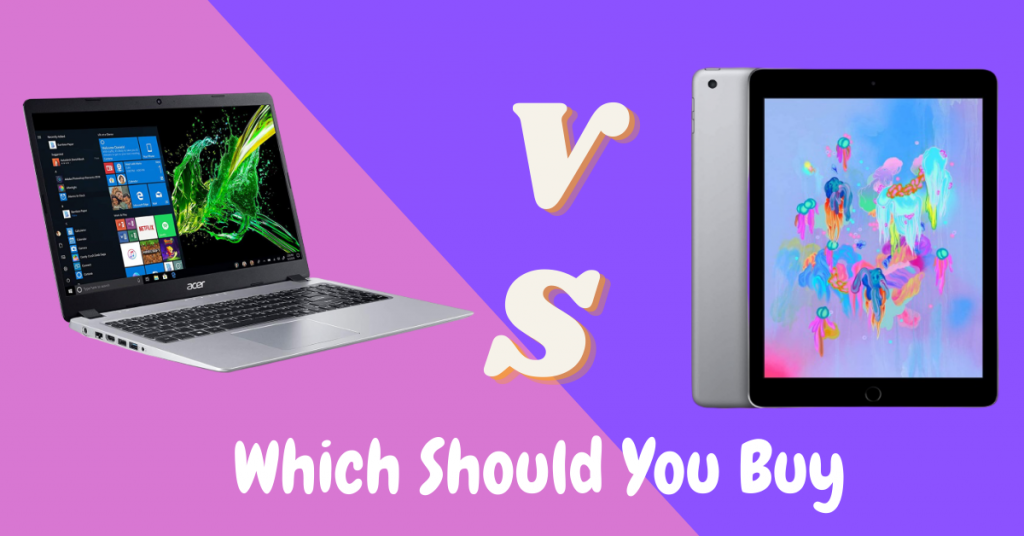Which is better laptop or tablet
You’re thinking about purchasing another tablet or laptop but yet can’t conclude which to pick? That is nothing unexpected. The present ultra-compact, ultra-practical tablet laptops can work almost as undeniable laptops – propelled portable applications permit you to ride the web, run spreadsheets or word preparing applications, play intelligent games, etc.

Laptop vs tablet pros and cons
However a few clients see a tablet’s touch screen interface as constraining, and others favor a normal console over a virtual, on-screen one.
Tablets depend exclusively on a touchscreen interface for input, which can introduce difficulties when you have to include text. Since tablets have no console, you should type on virtual consoles that have fluctuating formats and structures. 2-in-1 tablets accompany a separable console.
However, these models despite everything miss the mark regarding the laptop experience as a result of their litter size and more prohibitive structures.
On the off chance that you include an outer Bluetooth console, you’ll include expenses and peripherals that must be conveyed with the tablet, making it less compact.
Laptops are better for individuals who type a great deal.
Display
While we’re at the subject of size, we should make reference to the showcase, and there are two key elements to consider here: size and goal. As far as sheer volume, laptops will, normally, consistently have the advantage as their bigger casings take into account bigger screens.
In any case, when the goal is contemplated, the littler tablet show would offer higher pixel thickness, implying that the shown picture would be more honed, and individual pixels would not be as noticeable.
Tablets with up to Full HD (1080p) goals give fine surveys given them relatively litter sizes. Be that as it may, models with Quad HD (1440p) or more noteworthy presentations (presently well known in workstations) are rarer, due both to their processor requests and on the grounds that high-res showcases can make exact touch-orders more troublesome.
Portability
As a matter of first importance, there’s the topic of convertibility. Also, in most cases, tablets win undoubtedly.
Size-wise, tablets for the most part go from 7 to 13 inches, excluding some bigger tablet gadgets equipped towards proficient clients. Generally, 8-inch and 10-inch screens are the most well known in tablets since they figure out how to find some kind of harmony between screen size and ergonomics.
With regards to weight, they will in general weigh anywhere from around 300 grams (around 10 oz) in the instances of the littlest and lightest gadgets. Rather, they go as far as possible up to roughly 700 grams (about 1.5 lb) on account of bigger gadgets, for example, the 13-inch iPad Pro.
As far as weight, the normal 15-inch laptop weighs about 2kg (around 5 lb). Clearly, this is heavier than a tablet, however simply like with screen size, workstations spread a wide range when weight is concerned. A few scratchpads can undoubtedly weigh under 1kg, at the same time some gaming laptops can go over 4kg and much over 8kg in some outrageous cases.
Size
Most tablets weigh under two pounds. Indeed, even the littlest workstations, similar to the Apple MacBook Air 11, gauges more and has a profile bigger than most tablets. The fundamental explanation behind the bigger profile is that the console and trackpad occupy an extra room. Workstations that incorporate all the more impressive segments require extra cooling, which adds to the size. In light of their litter size and weight, a tablet is a lot simpler to heft around than a laptop, particularly for movement.
Storage
Storage capacity is another exceptionally significant factor to consider, and here, workstations quite often have the lead. As of now, the least expensive laptops typically accompany either a 500 GB HDD or a 128 GB SSD, the two of which bulldoze most tablets.
For the most part, tablets in 2020 territory normally from 8 GB to 256 GB when the interior stockpiling is concerned, however, some pricier very good quality models can likewise have as much as 512 GB or 1 TB of capacity. In any case, the default stockpiling limit isn’t all that matters – we should likewise think about expandable stockpiling.
In order to keep the size and costs of tablets down, makers rely upon solid-state amassing memory to store ventures and data. This innovation has one significant inconvenience: the measure of information it can store. Most tablets permit somewhere in the range of 16 and 128 gigabytes of capacity. By correlation, most workstations despite everything utilize regular hard drives that hold considerably more. The normal spending laptop accompanies a 500 GB hard drive, albeit a few laptops have moved to strong state drives also. The two workstations and tablets incorporate highlights like USB ports or microSD cards that make it conceivable to include outside capacity.
Conclusion – Which Should You Choose?
As should be obvious, tablets and workstations are altogether different gadgets, which is no big surprise considering that they were intended for totally different things.
All things considered, as Steve Jobs said when he presented the first iPad, tablets are proposed to occupy the space among cell phones and PCs and they should show improvement over both of the two.
All in all, what are those things that tablets show improvement over workstations, and which kind of gadget is, at last, the better decision for you?
In the event that you just need a gadget for perusing the web, watching recordings, tuning in to music, and playing easygoing games, at that point a tablet would most likely be the best counterpart for your need.
They are minimized, light, compact, flaunting astounding battery life, and most likely a superior showcase than what you’d get with a laptop in the lower value ranges. If so, look at our choice of the best tablets accessible at the present time.
